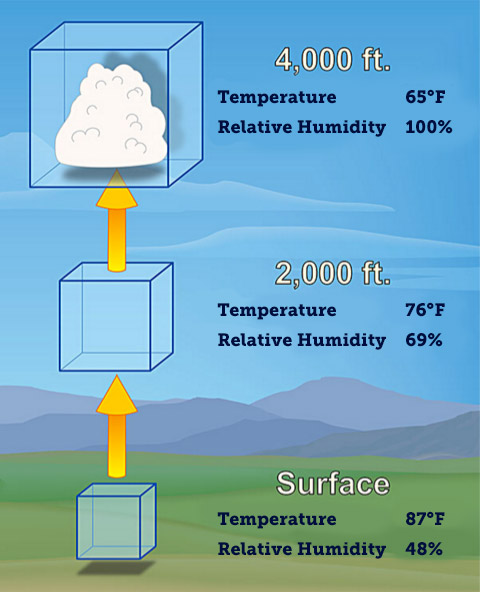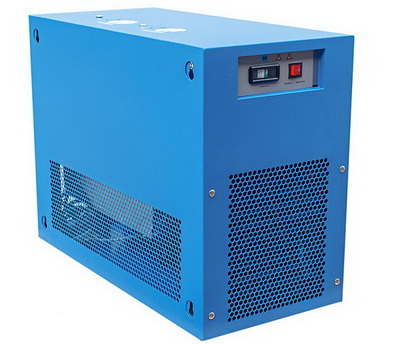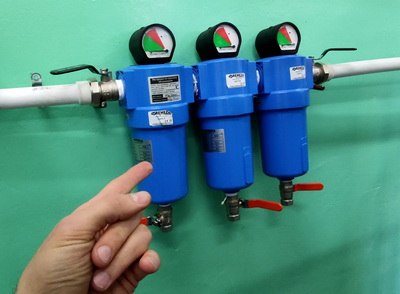Basic data
In this article we will cover another very interesting topic: the dew point of compressed air and gas. Let's begin by defining it:
The dew point (dew point temperature) is the temperature of air at which the moisture/water it contains reaches a state of saturation and begins to condense into dew. So, water droplets are formed at this temperature.
For example, it is very hot outside and the air temperature during the day is +82...+90 degrees Fahrenheit. We have moisture in the air and the relative humidity is 40%. It' s more or less comfortable for a man. The air and its humidity does not change and when the temperature drops to +59 ... +68 degrees Fahrenheit at night we can observe how dew is formed on the grass, which is essentially water droplets. This will be the dew point temperature for this air, in this case +59 ... +68 degrees Fahrenheit. Usually atmospheric air in summer has a dew point of +59 ... +68 degrees Fahrenheit. Too high dew-point as well as too low will be uncomfortable for people. And the dew point of +79 degrees Fahrenheit and above can be fatal for those who have asthma.
Another prime example of a dew point is clouds. The same air, the same humidity, but a different TEMPERATURE is what determines the condensation of water that turns into clouds. TEMPERATURE. At different temperatures, moisture condenses into clouds. The higher it is, the colder it is. This is formed by the fact that temperature is the speed of motion of gas molecules and as the temperature drops it slows down...... noooo, we won't go that far. This is where we pause and look at our practical problem.
 When we work with compressed air, with pressurized air, the situation changes and as we change the pressure, the humidity of the air increases dramatically. This is very easy to understand, because air is a gas that is very easy to compress, unlike water. We compress air up to 10 times and we get a pressure of 10 bar. This is the standard outlet pressure of a screw compressor. We have compressed air and water in it is not compressed, but it becomes 10 times more in terms of volume of air. So we understand why we get so much "condensate" in the air receiver when we compress air. We have compressed together the water particles which were in the air and now it is easier for them to condense (stick together to form droplets). And we engineers have the problem of how to get rid of this moisture.
When we work with compressed air, with pressurized air, the situation changes and as we change the pressure, the humidity of the air increases dramatically. This is very easy to understand, because air is a gas that is very easy to compress, unlike water. We compress air up to 10 times and we get a pressure of 10 bar. This is the standard outlet pressure of a screw compressor. We have compressed air and water in it is not compressed, but it becomes 10 times more in terms of volume of air. So we understand why we get so much "condensate" in the air receiver when we compress air. We have compressed together the water particles which were in the air and now it is easier for them to condense (stick together to form droplets). And we engineers have the problem of how to get rid of this moisture.
In our case, for the production of nitrogen and oxygen, the drip moisture is critical. If droplets get into the generator, it clogs the pores of the carbon molecular sieve and is not regenerated. The droplets do not come out of the adsorbent during normal operation. And if there is moisture in the pores, oxygen is not trapped and adsorption does not occur. In fact, this is the most "terrible" and expensive failure, in case of which the entire adsorbent has to be replaced.
In order to protect the adsorbent, a small layer of silica gel (simple desiccant) is placed in the generator, so that it absorbs moisture in case it gets there.
What can we do with the moisture?
Compressed air can be dried in two main ways: refrigeration dryer and adsorption dryer. These are fundamentally two different ways, each of them has its own advantages and disadvantages. In short, the situation is characterized as follows:
Refrigerant dehumidifier

It is a refrigerator that has a freon cooling circuit and air flows through the cooled air duct, due to the drop in temperature it condenses naturally and drains out. The equipment is simple to operate, inexpensive and very common. At the outlet of the dehumidifier we have a dew point of +38...+41 degrees Fahrenheit. It is quite enough for oxygen generator and nitrogen generator operation with low purity (up to 99,995%). No air losses. It consumes electricity but not much - electricity is needed only for compressor that pumps freon in cooling contour.
Adsorption dryer
.jpg)
Adsorption air dryer: these are two adsorption columns with silica gel or other special adsorbent. The two columns work alternately: while one works, the second is regenerated by compressed air from the other column. We get a kind of filter, which retains moisture. At the output we have a dew point of -104...-158 degrees Fahrenheit. There are cold regeneration dehumidifiers with a dew point of -104 degrees Fahrenheit (air losses of 10-15% which will simply escape into the atmosphere during regeneration) and hot regeneration where we get the dew point of -158 degrees Fahrenheit. Hot regeneration saves air for regeneration, but itself has power consumption for the heating elements. Adsorption dehumidifiers are much more expensive and more costly to maintain. We lose either air or electricity for heating.
Additional methods
 Part of the moisture immediately accumulates in the air receiver before it reaches the dehumidifier. We recommend installing an automatic condensate drain on the air receiver to facilitate the operation of the dehumidifier. Some more moisture is left on filters (5 microns, 1 micron). Often there is also an automatic condensate drain on filters. There is also such a device as a separator - a simple device that repels moisture purely mechanically, by means of whirling. It is used when there is a lot of moisture in the ambient air, for example in Africa.
Part of the moisture immediately accumulates in the air receiver before it reaches the dehumidifier. We recommend installing an automatic condensate drain on the air receiver to facilitate the operation of the dehumidifier. Some more moisture is left on filters (5 microns, 1 micron). Often there is also an automatic condensate drain on filters. There is also such a device as a separator - a simple device that repels moisture purely mechanically, by means of whirling. It is used when there is a lot of moisture in the ambient air, for example in Africa.
The generator itself also retains a lot of moisture and if it is not dripping, it is easily regenerated. At the outlet of nitrogen and oxygen generator when using standard filters and refrigerator dehumidifier we get gas with dew-point of -122...-131 degrees Fahrenheit. If we use adsorption dehumidifier, the dew-point may be -158...-172 degrees Fahrenheit. This, by the way, allows us to run a nitrogen or oxygen line down the street and not be afraid that condensate will form.
In the next article we will discuss how to measure the dew point and why we need to measure it.

